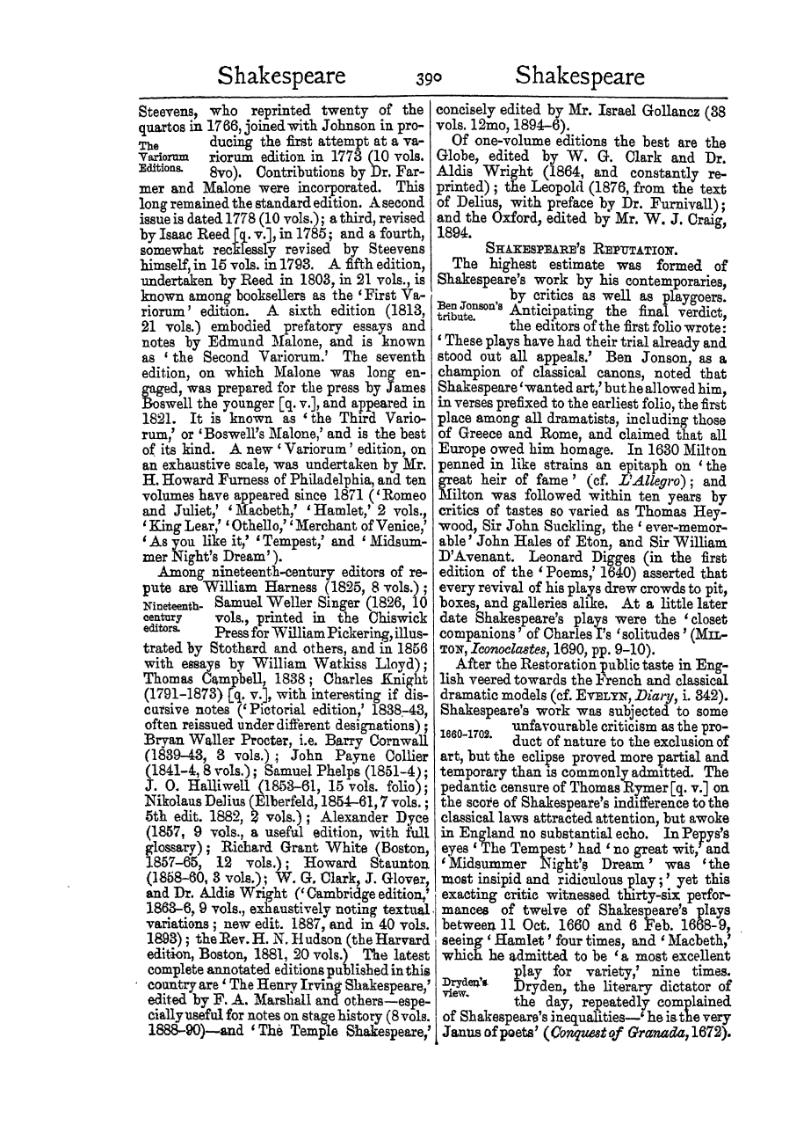Steevens, who reprinted twenty of the quartos in 1766, joined with Johnson in producing the first attempt at a The Variorum Editions. variorum edition in 1773 (10 vols. 8vo). Contributions by Dr. Farmer and Malone were incorporated. This long remained the standard edition. A second issue is dated 1778 (10 vols.); a third, revised by Isaac Reed [q. v.], in 1785; and a fourth, somewhat recklessly revised by Steevens himself, in 15 vols. in 1793. A fifth edition, undertaken by Reed in 1803, in 21 vols., is known among booksellers as the ‘First Variorum’ edition. A sixth edition (1813, 21 vols.) embodied prefatory essays and notes by Edmund Malone, and is known as ‘the Second Variorum.’ The seventh edition, on which Malone was long engaged, was prepared for the press by James Boswell the younger [q. v.], and appeared in 1821. It is known as ‘the Third Variorum,’ or ‘Boswell's Malone,’ and is the best of its kind. A new ‘Variorum’ edition, on an exhaustive scale, was undertaken by Mr. H. Howard Furness of Philadelphia, and ten volumes have appeared since 1871 (including ‘Macbeth,’ ‘Hamlet,’ 2 vols., ‘King Lear,’ ‘Othello,’ ‘Merchant of Venice,’ ‘As you like it,’ ‘Tempest,’ and ‘Midsummer Night's Dream’).
Among nineteenth-century editors of repute are William Harness (1825, 8 vols.); Samuel Weller Singer (1826, 10 vols., Nineteenth-century editors.printed in the Chiswick Press for William Pickering, illustrated by Stothard and others, and in 1856 with essays by William Watkiss Lloyd); Thomas Campbell, 1838; Charles Knight (1791–1873) [q. v.], with interesting if discursive notes (‘Pictorial edition,’ 1838–43, often reissued under different designations); Bryan Waller Procter, i.e. Barry Cornwall (1839–43, 3 vols.); John Payne Collier (1841–4, 8 vols.); Samuel Phelps (1851–4); J. O. Halliwell (1853–61, 15 vols. folio); Nikolaus Delius (Elberfeld, 1854–61, 7 vols.; 5th edit. 1882, 2 vols.); Alexander Dyce (1857, 9 vols., a useful edition, with full glossary); Richard Grant White (Boston 1857–65, 12 vols.); Howard Staunton (1858–60, 3 vols.); W. G. Clark, J. Glover, and Dr. Aldis Wright (‘Cambridge edition,’ 1863–6, 9 vols., exhaustively noting textual variations; new edit. 1887, and in 40 vols. 1893); the Rev. H. N. Hudson (1851–6, 11 vols., reissued as Harvard edition, Boston, 1881, 20 vols.). The latest complete annotated editions are ‘The Henry Irving Shakespeare,’ ed. F. A. Marshall and others—especially useful for notes on stage history (8 vols. 1888–90)—‘The Temple Shakespeare,’ concisely edited by Mr. Israel Gollancz (38 vols. 12mo, 1894–6), and the Eversley Shakespeare, ed. Prof. Harford, 10 vols. 1899.
Of one-volume editions the best are the Globe, edited by W. G. Clark and Dr. Aldis Wright (1864, and constantly reprinted); the Leopold (1876, from the text of Delius, with preface by Dr. Furnivall); and the Oxford (1894), ed. W. J. Craig (1843–1906).
Shakespeare's Reputation.
The highest estimate was formed of Shakespeare's work by his contemporaries, by critics as well as playgoers. Anticipating the final verdict, the editors of the first Ben Jonson's tribute.folio wrote: ‘These plays have had their trial already and stood out all appeals.’ Ben Jonson, as a champion of classical canons, noted that Shakespeare ‘wanted art,’ but he allowed him, in verses prefixed to the earliest folio, the first place among all dramatists, including those of Greece and Rome, and claimed that all Europe owed him homage. In 1630 Milton penned in like strains an epitaph on ‘the great heir of fame’ (cf. L'Allegro); and Milton was followed within ten years by critics of tastes so varied as Thomas Heywood, Sir John Suckling, the ‘ever-memorable’ John Hales of Eton, and Sir William D'Avenant. Leonard Digges (in the first edition of the ‘Poems,’ 1640) asserted that every revival of his plays drew crowds to pit, boxes, and galleries alike. At a little later date Shakespeare's plays were the ‘closet companions’ of Charles I's ‘solitudes’ (Milton, Iconoclastes, 1690, pp. 9–10).
After the Restoration public taste in English veered towards the French and classical dramatic models (cf. Evelyn, Diary, i. 342). Shakespeare's work was subjected to some unfavourable criticism as the product of 1660–1702.nature to the exclusion of art, but the eclipse proved more partial and temporary than is commonly admitted. The pedantic censure of Thomas Rymer [q. v.] on the score of Shakespeare's indifference to the classical laws attracted attention, but awoke in England no substantial echo. In Pepys's eyes ‘The Tempest’ had ‘no great wit,’ and ‘Midsummer Night's Dream’ was ‘the most insipid and ridiculous play;’ yet this exacting critic witnessed thirty-six performances of twelve of Shakespeare's plays between 11 Oct. 1660 and 6 Feb. 1668–9, seeing ‘Hamlet’ four times, and ‘Macbeth,’ which he admitted to be ‘a most excellent play for variety,’ nine times. Dryden, the literary Dryden's view.dictator of the day, repeatedly complained of Shakespeare's inequalities—‘he is the very Janus of poets’ (Conquest of Granada, 1672).
